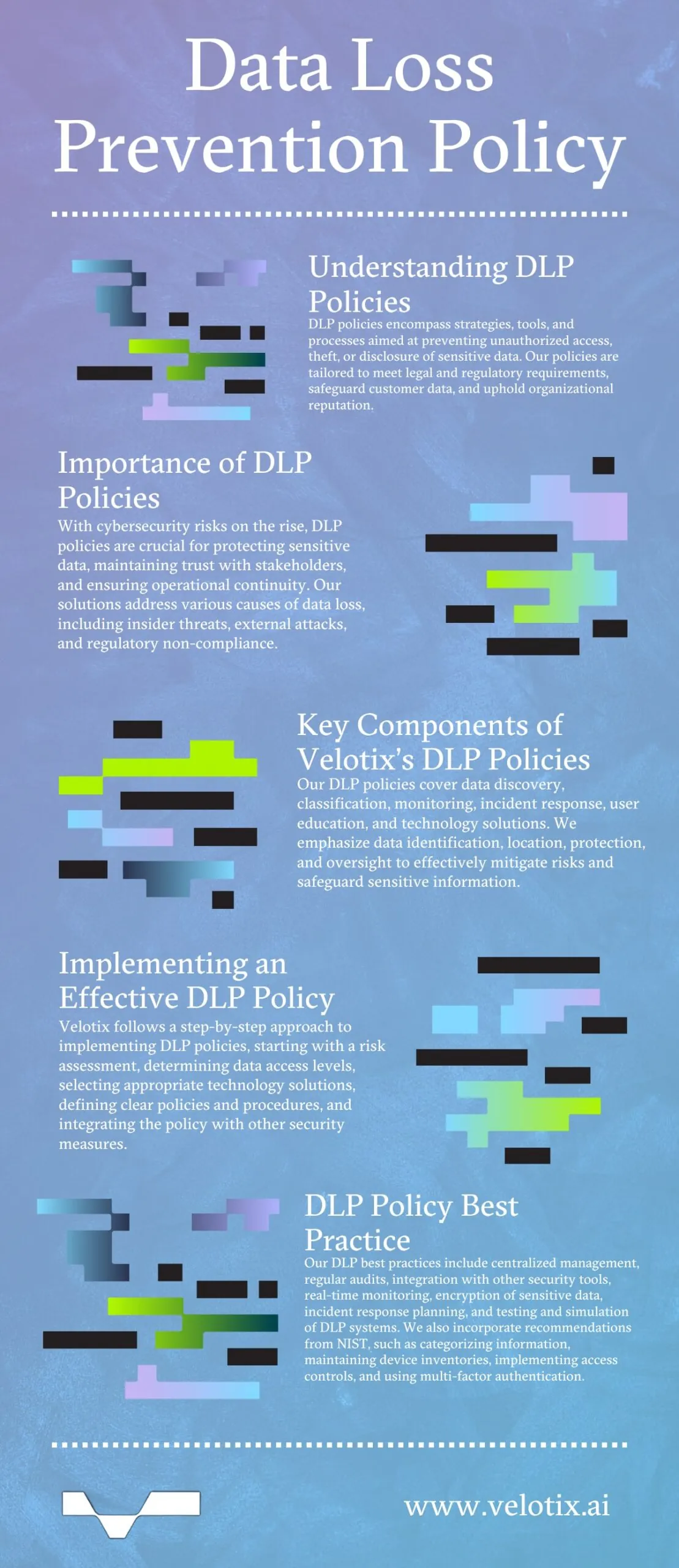The World Economic Forum’s 2023 Global Risks Report lists cybersecurity as a top ten short and long term global risk. With data now a pivotal asset for organizations, data loss prevention (DLP) policies provide an essential framework for protecting valuable information and maintaining operational integrity.
DLP tools have evolved to offer advanced features like content inspection, analysis, and machine learning to detect unusual data movement patterns. Such technological advancements ensure sensitive data remains within an organization. However, while technology plays a significant role in DLP, the human element is equally important, with successful DLP policies relying on a well-informed and vigilant workforce to support technological safeguards.
What is a Data Loss Prevention Policy
Data loss prevention policy is the strategies, tools, and processes organizations use to prevent unauthorized access, theft, or disclosure of sensitive information. Its primary purpose is to protect organizational data and ensure it doesn’t end up in the wrong hands, whether due to intent, accident, or negligence.
Organizations adopt DLP policies to meet legal and regulatory compliance requirements, safeguard customer data, and maintain their trustworthiness and reputation. The policies they adopt vary based on specific needs, the data’s nature, and the potential risks they face.
Specialized data loss prevention solutions can be used to enforce a data loss prevention policy’s directives, providing organizations with a centralized approach to data classification, monitoring, and access control implementation.

Why Data Loss Prevention Policies Matter
The primary causes of data loss include malicious insiders, negligent employees, and external threats. Along with regulatory and compliance requirements, DLP policies are essential for several reasons:
- Protection of sensitive data, including customer personally identifiable information (PII), financial records, trade secrets, and research data that, if exposed, could have dire consequences.
- Financial implications that occur with data breaches such as fines, compensations, lost business, and legal fees.
- Maintaining trust with customers, clients, and stakeholders by preventing breaches that could have long-term impacts on customer loyalty and business relationships.
- Operational continuity in the face of data breaches.
- Monitoring and mitigating insider threats, whether by accident or maliciousness.
- They act as a first-line defense against ransomware, phishing, and advanced cyberattacks.
- To meet remote and hybrid workforce challenges that arise with broader adoption of cloud technologies and BYOD policies.
- Minimizing incident response time so breach consequences are mitigated and corrective action is taken quickly.
- They support user awareness and training that educates employees about data’s value, the risks of mishandling it, and what steps they should take to protect it.
Key Components of a Data Loss Prevention Policy
Main aspects typically addressed by a DLP policy include data discovery, classification, locking down, and monitoring.
- Data identification, including PII, financial data, and intellectual property.
- Data location, whether in databases, cloud storage, or file servers.
- Monitoring and controlling sensitive data in motion, especially when transmitted outside the organization.
- Protecting data at rest, or where it’s stored.
- Overseeing data in use and ensuring only authorized users can access certain information.
- Incident response procedures for when a data breach is detected.
- User education and training, including regular training sessions and updates.
- Technology solutions that help detect and prevent unauthorized data access or transfer.
- Routine reviews and audits that measure the DLP policies’ effectiveness.
Steps to Implement an Effective Data Loss Prevention Policy
A step-by-step approach to implementing a DLP policy includes:
- Conducting a risk assessment that identifies potential vulnerabilities and threats and evaluates risks associated with third-party vendors and partners with access to your data.
- Determining data access levels and deciding who should have access to what data. Users should only have access to the data they need to perform their tasks.
- Choosing the DLP technology that aligns with your needs. It should be equipped to monitor data in motion, at rest, and in use.
- Defining clear policies and procedures as well as policy violation consequences.
- Integrating the policy with other security measures like firewalls, endpoint protection, and intrusion detection systems.
- Soliciting feedback for continuous improvement.
- Keeping informed of emerging threats, technologies, and best practices related to data protection.
Data Loss Prevention Policy Best Practices
As you move forward to apply data loss prevention policies, these best practices will bolster your DLP strategies and ensure optimal protection against data loss.
General DLP Best Practices
Adhering to these general DLP guidelines provides a structured approach to safeguarding your data assets effectively:
- Centralized management for DLP policies to ensure consistency and ease of governance.
- Regular audits to review data access rights and the DLP policy’s effectiveness.
- Integrate DLP solutions with other security tools for comprehensive protection.
- Use real-time monitoring to detect and respond instantly to threats.
- Encrypt sensitive data in transit and at rest.
- Devise an incident response plan for any breach or data loss scenarios.
- Test and simulate DLP systems to ensure they’re effective and identify weak points.
DLP Best Practices Inspired by NIST
The NIST (National Institute of Standards and Technology) data loss prevention policy includes additional recommendations, including:
- Categorizing information per the NIST risk management framework, identifying what data is most critical and sensitive.
- Maintaining an inventory of all devices and endpoints that access, store, or transmit sensitive data.
- Implementing access controls that ensure users only have access to data they need.
- Regularly updating and patching to ensure systems, applications, and security tools are up-to-date.
- Using multi-factor authentication, especially for users who want to access sensitive data or systems.
- Documenting all DLP policies, procedures, and incidents.
Reviewing and revising DLP policies to ensure they’re current and effective.
